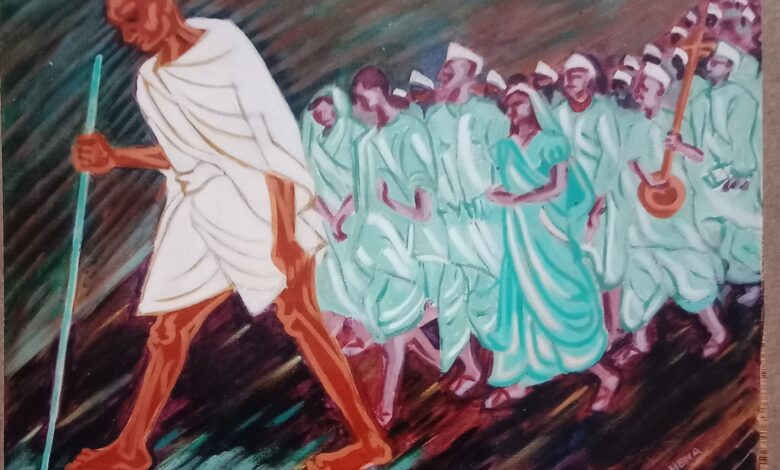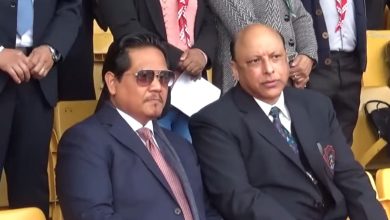Salt satyagraha: The saga of non-violence in action

 March 12, 2023. Exactly 93 years ago on March 12, 1930, one of the greatest movements to awaken the country and her citizens began. The ground was prepared by a 60-plus man with a staff in hand, when he decided to foot march from Sabarmati to Dandi to break the unjust salt tax imposed by the British. Mahatma Gandhi had indeed given a clarion call for world sympathy in this “battle of right against might”.
March 12, 2023. Exactly 93 years ago on March 12, 1930, one of the greatest movements to awaken the country and her citizens began. The ground was prepared by a 60-plus man with a staff in hand, when he decided to foot march from Sabarmati to Dandi to break the unjust salt tax imposed by the British. Mahatma Gandhi had indeed given a clarion call for world sympathy in this “battle of right against might”.
Gandhi had begun the march with 78 of his satyagrahis barring different age groups — the oldest, 61-year-old Gandhi himself; and the youngest, an 18-year-old — to cover a trek of 385.6-km (almost 241 miles); across 47 villages; over 24 days and nights, starting from Sabarmati Ashram in Ahmedabad and ending in Dandi in coastal Surat — from March 12 to April 6 — in a nonviolent march towards freedom.
Seeing this enthusiasm of the swaying crowd that joined Mahatma Gandhi in villages to villages that he traversed during the Salt March, Jawaharlal Nehru expressed, “It seemed as though a spring had been suddenly released.”
Why Salt?
It is noteworthy to reflect that Mahatma Gandhi wrote his first article on ‘salt’ as early as February 14, 1891. He was twenty-two. The article appeared in The Vegetarian, where he described the utter poverty of his fellow country-men who lived on bread and salt, a ‘heavily taxed article’ (source: The Collected Works of Mahatma Gandhi, 1894-96, Vol. I. (Ahmedabad, 1958), pp.24ff.) Similar views appeared time and again from him during his sojourn in South Africa.
It was also in Hind Swaraj that he wrote: “The salt-tax is not a small injustice”. Therefore, the object, ‘salt’, too was carefully chosen that was directly linked with the survival of the people and it had roused the conscience of a sleeping nation towards a non-violent struggle.
Mahatma Gandhi clearly understood that salt was the only relish that the teeming poor in Indian villages could afford in their monotonous diet and that it was perhaps the greatest necessity of life and taxing it increased the burden.
One could also argue that in choosing ‘salt’ as his strategic weapon to reach the goal of ‘swaraj’, Mahatma Gandhi was clearly addressing issues of the environment, not as an ecologist, but as a conscious thinker who by his life’s example had propagated the idea of being a minimalist. The Mahatma said: “Next to air and water, salt is perhaps the greatest necessity of life.”
The Method beyond Salt
Given his personal life of extraordinary simplicity and his identification with his countrymen, through this Salt March, Gandhiji inspired and motivated the teeming millions to follow him. He was able to appeal to their intellect and heart by understanding their suffering and exploitation.
Secondly, Gandhiji utilised this moment (read march) to target issues of the ‘caste divide’ in the villages en route. This was evident as he chose to stay in the so-called ‘untouchable’ quarters and drew water from the well there for his wash. By also staying at Sirajuddin Vasi’s (better known as Shiraz Abdulla) place a powerful message of brotherhood was sent.
Thirdly, he inspired women to lead for the first time. From Kasturba Gandhi, his wife, to Sarojini Naidu to the Parsi social worker Mithuben Petit, to other women leaders like Kamaladevi Chattopadhyay, Hansa Mehta, Amina Tyabji, and Rukmini Lakshmipathy, the women led the protest at other places and broke the salt law and also courted imprisonment.
Finally, this saga of non-violence in action was demonstrated by the nonviolent satyagrahis as they faced the brutality of the oppressors with patience and steadfastness, especially at Dharasana, 25 miles south of Dandi. The amazing self-discipline of the satyagrahis in the face of repressive violence was demonstrated.
Webb Miller of the United Press, an eye-witness to the events that unfolded in Dharsana (on route to Dandi in Gujarat) on May 21, 1930 says that as blows from the steel-shod lathis (sticks) rained upon the satyagrahis, not one of the marchers even raised an arm to fend off the blows…Those struck down fell sprawling, unconscious or writhing with fractured skulls or broken shoulders… The survivors, without breaking ranks, silently and doggedly marched on until struck down.”
Gandhi’s Dandi Yatra – A Pilgrim’s Progress
The march of 1930 was intended towards awakening the people. Gandhi embodied the tradition of pilgrimages and added his own values of spiritualism to it that he had imbibed through this travel across the length and breadth of the country. He himself had said this his feeling was like that of the pilgrims of Amarnath or Badri-Kedar.
This small voice had expounded the glories of freedom and the beauties of the moral life. It was almost like a mythical quest for a pilgrim. Mahatma Gandhi had immersed himself deeply in this role of nonviolent struggle, leading his nonviolent forces to a triumphant moral victory. He believed that “Nonviolence is like the radium in action”.
As Mahatma Gandhi stood up with a lump of salt in one hand and said, “With this, I am shaking the foundations of the British Empire,” there were around 60,000 to 100,000 marchers behind him. Never had so many people shown themselves willing to suffer for the cause; never had such exemplary discipline been shown; never had so large a campaign been carried on without breaking down into violence; never had women and peasants been so deeply involved.
This was because Mahatma Gandhi was able to touch the ‘Soul’, ‘Soil’ and ‘Society’” and embrace them in his constructive actions.





